How To Stop Sap From Coming Out Of Wood (Detailed Explanation!)
Sap coming out of wood while seated on a bench, deck, or shade tree is a nuisance. Particularly when it comes into contact with your clothes. However, the good news is that you can stop the sap from oozing from wood.
So, how to stop sap from coming out of wood? You can crystalize it using sugar, heat, or a solvent to dissolve it. Since it’s a continuous growth process, especially in trees, you can scrap it off or sand off the sap every time it comes out. For wood furniture, consider painting or staining to prevent further sap oozing.
This article will discuss the various methods of stopping sap from coming from wood step-by-step. Stay a little to have some tips and precautions as well.
How To Stop Sap From Coming Out Of Wood (Detailed Explanation!)
To stop sap from coming out of wood, you need to locate the oozing points and seal completely using adhesives and sealants. Clean the sap from the wood surface by scraping it off and dissolving the sap using solvents.
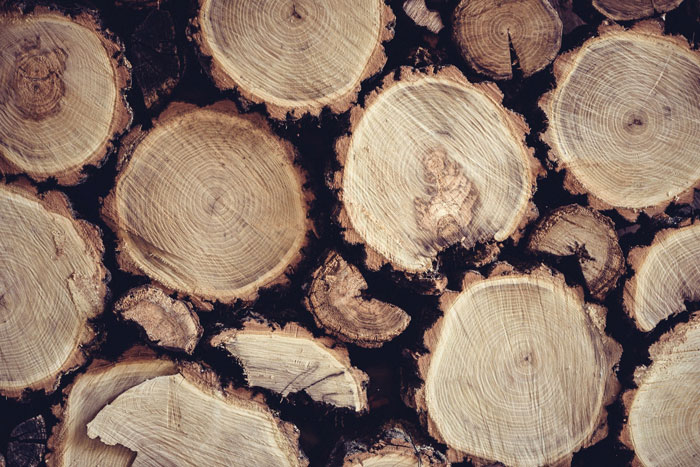
Followed by drying the wood in sunlight to crystallize the sap in it. Apply sealants in the cracks and oozing weak points on the wood surface. You can also paint or stain the wood surface to seal the weak points.
There are several ways to stop sap from oozing from trees and cut wood. Let’s look at various methods to prevent sap from bleeding from wood.
Method 1: Heating The Sap To Dissolve It
This method is efficient when the sap is hardened and stuck on wood. You need a source of heat – preferably a portable source like a simple hand-burner, or you light a small stick.
When heating it, keep a distance of about 15 cm away from the sap to avoid damaging the wood. The aim is to melt or dissolve the sap without direct contact heating. Avoid using flames to dissolve the sap and use burning charcoal.
The sap will melt away at the right temperature, depending on its hardness. You can collect it in a container as a natural adhesive or for making sugar additives and alcohol.
Wipe the sap clean using a cloth, and your wood will be free from any sap.
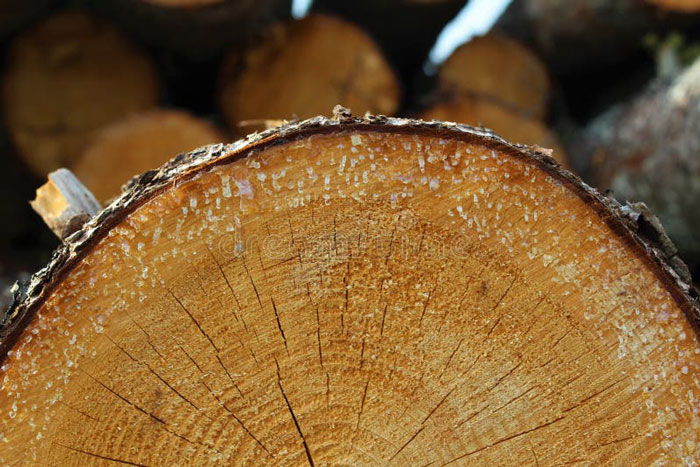
Method 2: Using Solvents To Dissolve The Sap
Solvents such as distilled alcohol and mineral spirits from the stores can dissolve the sap, especially where heat fails to perform. You can also apply these solvents where heat is discouraged in furniture.
To dissolve the sap, follow the steps below.
Step 1: Wear protective gear like gloves and mask to prevent direct contact with the solvent and sap.
Step 2: Pour the solvent of your choice into a bowl or container.
Step 3: Cut a cloth and soak it in the solvent. Allow it to sit for about five minutes.
Step 4: Apply the solvent on the sap, concentrating on the base at which the sap is attached to the wood.
Step 5: Let the soaked cloth sit on the sap for about five minutes for the sap to dissolve.
Step 6: Use the cloth to wipe off the dissolved sap. Once you clean any residue, your wood will be clean, with no more sap oozing.
Method 3: Crystalize The Sap And Scrap It Off
The crystallization of sap is used when the sap is still liquid before it hardens. You can observe the sap flowing in mass down the wood. Once the sap solidifies on the wood, it stains and becomes hard to remove.
Follow the steps below to crystallize sap and scrap it off.
Step 1: Wear protective gear like gloves to avoid contact with the sap.
Step 2: Prepare a sugar solution by mixing water and sugar in a ratio of 1:1, respectively, and stir it to dissolve.
Step 3: Apply the sugar solution on the wet sap using a cloth soaked in the sugar solution. Allow the sap to absorb the sugar solution for at least ten minutes.
Step 4: Remove the soaked cloth once the sap crystallizes.
Step 5: Scrap off the crystallized sap using the backside of a knife or any sharp object. Avoid damaging the wood with sharp objects.
Your wood is now clean, and you have stopped the sap from oozing.
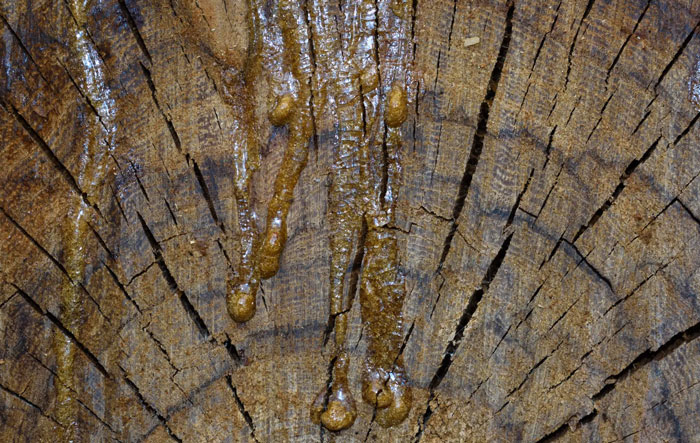
Method 4: Scraping It Off Or Sanding It Off
Since oozing is a continuous growth process, especially for live trees, you may choose to scrap it off or sand it off every time it oozes.
This method is simple and efficient since you need a sharp scooping knife and sandpaper to remove the sap. Follow the steps below to remove the sap.
Step 1: Identify the weak points from where sap oozes frequently.
Step 2: Use a scooping knife to scrape off the sap that has oozed and solidified on the wood.
Step 3: Use fine grit sandpaper to smoothen any remaining sap on the wood
Scrapping and sanding sap from wood requires progressive removal every time the sap is exuded. It is easy but tedious, especially from a frequently used piece of furniture.
How To Seal And Completely Stop The Sap From Coming Out Of Wood
After removing sap from wood, more sap may be produced, especially if the wood is not well-dried. Therefore, you need to seal the wood and prevent further sap from coming out.
You can apply three methods to seal any weak points on your wood and stop the oozing process.
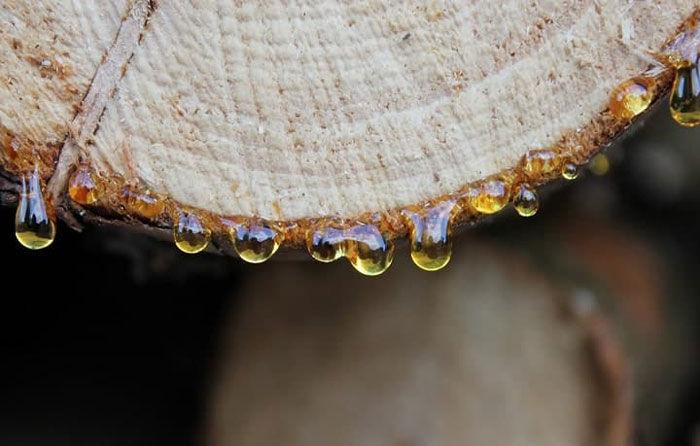
Method 1: Painting The Wood
Once you stop the oozing process, it’s advisable to paint the wood and seal any weak points that sap can ooze from. Apply a first thin coat of paint and allow it to be absorbed by the wood. Concentrate on all oozing points and apply several coats.
Once the paint dries, the wood is sealed with a thick paint layer, and no more oozing of the sap.
Method 2: Fill Up Cracks With Wood Adhesive
Cracks are the significant points from which sap oozes. Therefore, you need to fill those cracks to completely stop the sap from coming out. The best adhesive for filling cracks on wood includes wood putty, epoxy, wood filler, and fide glue mixed with sawdust.
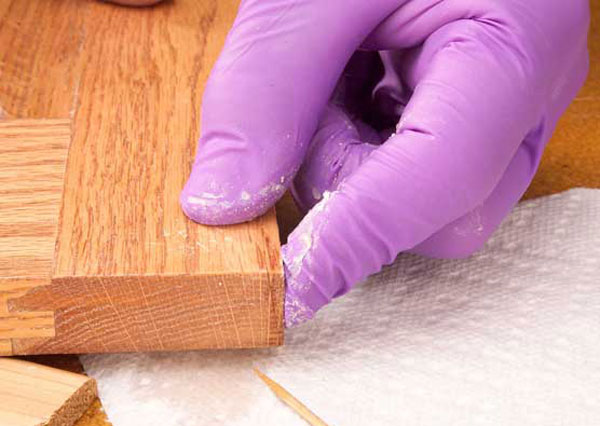
Follow the steps below to fill the cracks in the wood.
Step 1: Put your preferred wood glue in a container or lid – pour just the required amount to avoid wastage.
Step 2: Add fine sawdust and stir till they mix.
Step 3: Clean the cracks to be filled and remove any sap in them.
Step 4: Fill the cracks with the glue and sawdust mix using a stick.
Step 5: Allow the glue to sit and dry for about one hour.
Step 6: Sand off the excess glue after it has dried using fine grit sandpaper.
Method 3: Staining The Wood
Staining wood follows a similar process to painting. However, staining involves using varnish, water, or oil-based stains to achieve a natural finish, which is absorbed into the wood.
To stain your wood, follow the steps below.
Step 1: Choose your preferred staining solvent, such as varnish or oil-based stains.
Step 2: Mix the Stainer with turpentine in the ratio of 2:1 respectively.
Step 3: Apply a thin layer of stain using a soft brush and let it dry.
Step 4: Let the first layer dry and add other coatings. Emphasize any cracks and weak points that sap ooze from.
Your wood is now fully sealed, and sap will not ooze from it anymore.
FAQs
Below are questions to help you better understand how to stop sap from coming out of wood.
Q: Why Does Sap Come Out Of Wood?
Sap comes out of wood due to improper drying before using it for furniture or other purposes. The sap oozes from the wood when the temperatures rise, and it finds its way out through a weak point.
For growing live trees, sap is generated seasonally as a biological process to help trees photosynthesis. The excess sap is exuded through cracks and weak points.
Q: Is Sap From Wood Harmful To Humans?
No. Sap from wood is not harmful to humans but is sticky and smells foul, especially in liquid form.
The sap becomes a problem to remove when it sticks to your clothes, skin, or shoes or falls on your vehicle pane. To remove it, scrub it with a soft brush with mineral spirits and hot water.
Q: How Long Does One Need To Dry Wood To Ensure Sap Does Not Come Out Of Wood?
For maximum drying of wood for furniture use, dry wood in natural sunlight for at least five days. If you use an oven to dry the wood, kiln dry it to 170F for 3-4 hours till the sap crystallizes.
Avoid excessive drying, as the wood will deform and lose its original shape.
Conclusion
Wood sap can be a nuisance when it comes into contact with fabrics, thus necessitating its removal and sealing to stop it from oozing. The above methods will remove and prevent the sap from coming out of the wood and keep your deck safe and clean.
However, you can stop the sap from oozing by adequately drying the wood before using it for furniture. Drying is efficient as it allows the sap to crystallize inside the wood. You can paint, stain, or fill up the cracks on wood to prevent further sap from oozing.





